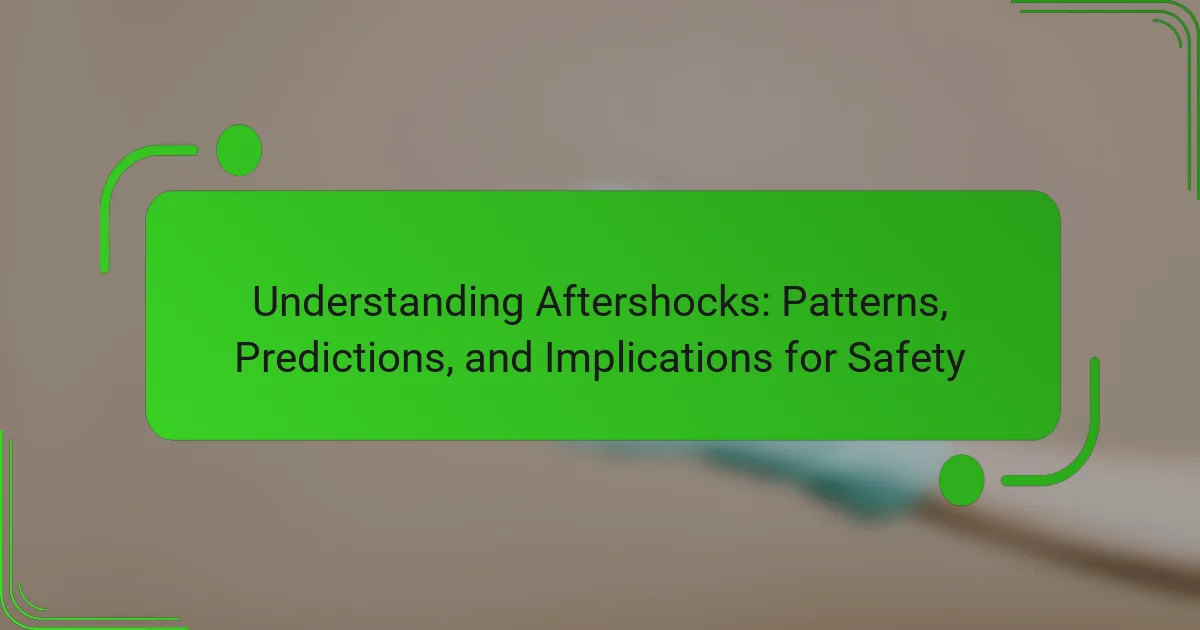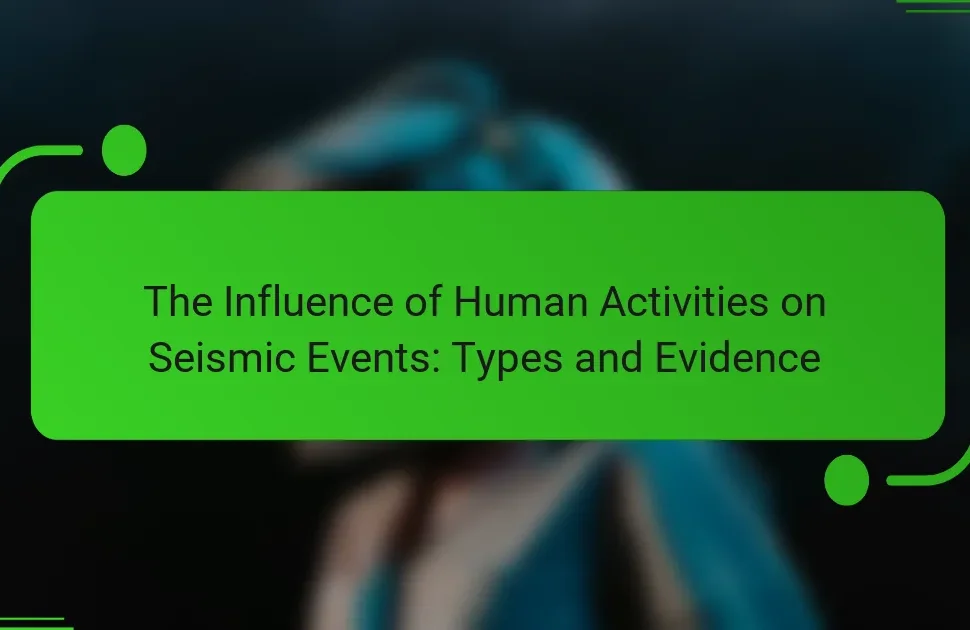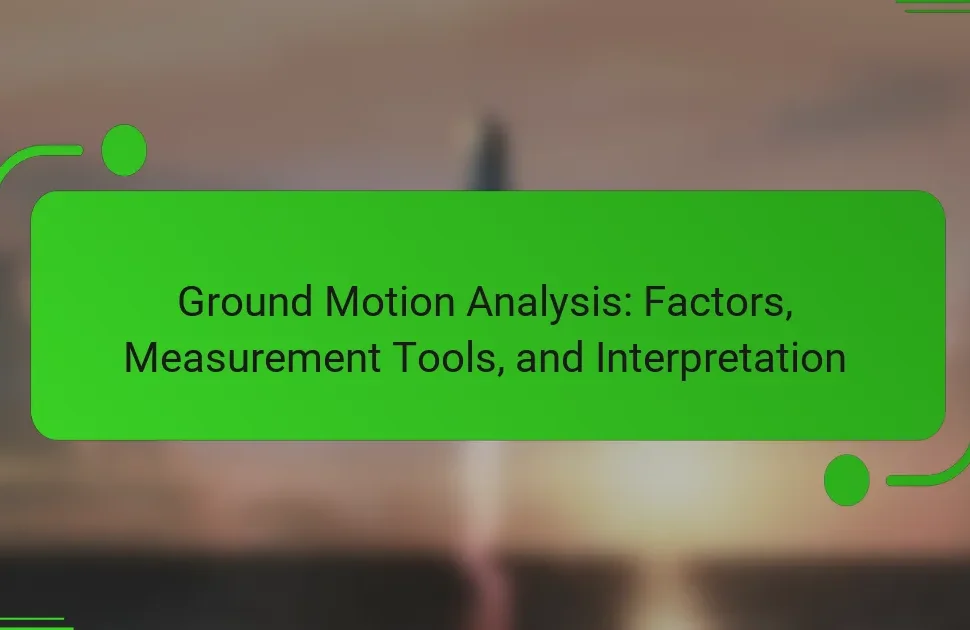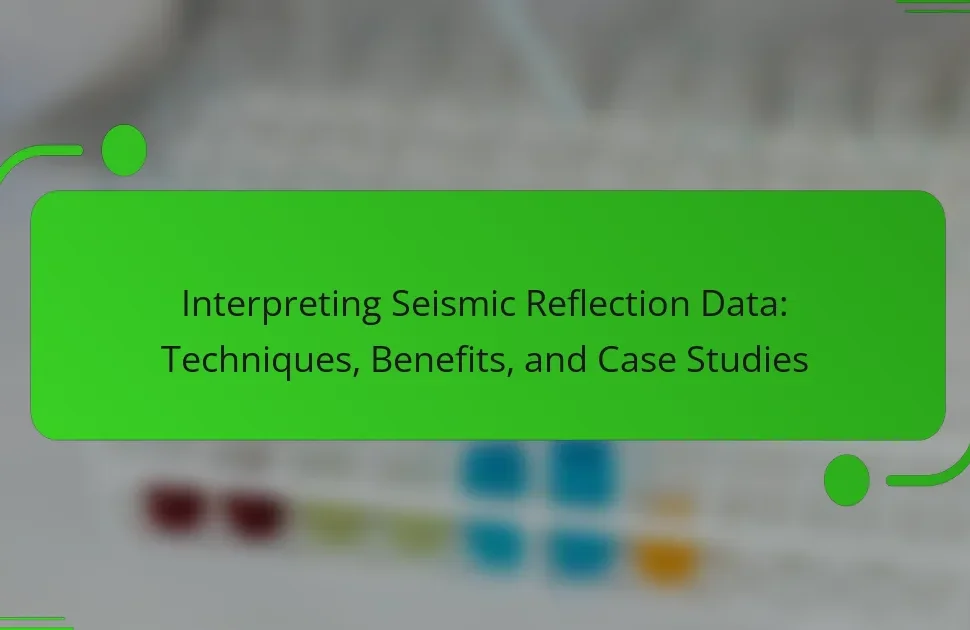Aftershocks are smaller earthquakes that follow a larger seismic event, occurring as the Earth’s crust adjusts to changes in stress. This article explores the patterns, predictions, and implications of aftershocks for safety. It discusses their varying magnitudes and frequencies, the statistical models and seismic data used for prediction, and the impact of aftershocks on structural integrity and public safety. The analysis includes the Omori-Utsu law and the application of machine learning techniques to enhance prediction accuracy. Understanding aftershocks is crucial for minimizing risks and ensuring effective emergency response in the aftermath of major earthquakes.
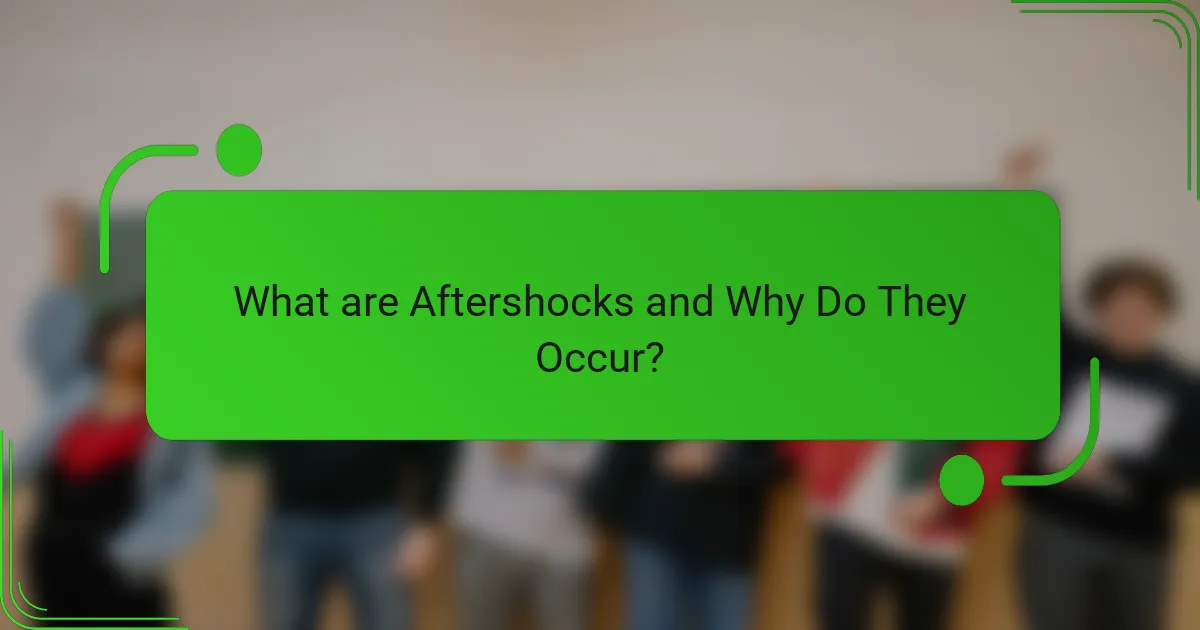
What are Aftershocks and Why Do They Occur?
Aftershocks are smaller earthquakes that occur in the same area after a larger seismic event. They happen as the Earth’s crust adjusts to the changes in stress caused by the main shock. Aftershocks can vary in magnitude and frequency. They typically decrease in intensity and occurrence over time. The largest aftershock usually follows the main shock within days to weeks. Research shows that aftershocks can occur for months or even years after the initial earthquake. The phenomenon is a natural part of the seismic process as the tectonic plates settle into a new equilibrium.
How do Aftershocks differ from the main earthquake?
Aftershocks are smaller seismic events that occur following the main earthquake. The main earthquake releases a significant amount of energy, causing widespread shaking and damage. Aftershocks typically occur in the same general area as the main quake. They can happen days, weeks, or even months after the initial event. The magnitude of aftershocks is usually lower than that of the main earthquake. For instance, aftershocks are often one to two magnitudes smaller. The frequency of aftershocks decreases over time. Studies show that aftershocks can be numerous in the days immediately following the main quake. This pattern is a result of the Earth’s crust adjusting after the initial release of stress.
What is the typical duration and frequency of Aftershocks?
Aftershocks typically last from a few seconds to several minutes. Their frequency can vary significantly. Generally, aftershocks occur in the days to weeks following a major earthquake. However, they can continue for months or even years. The largest aftershocks tend to happen within the first few days. Studies show that the frequency decreases over time. For instance, after a magnitude 7.0 earthquake, thousands of aftershocks may occur, but this number drops sharply within weeks. This pattern is observed in various seismic events globally.
What factors influence the strength of Aftershocks?
The strength of aftershocks is influenced by several factors. The magnitude of the mainshock is a primary determinant. Larger mainshocks typically produce stronger aftershocks. The geological characteristics of the fault zone also play a crucial role. Different rock types and fault configurations can affect aftershock behavior. The depth of the mainshock influences aftershock intensity as well. Shallower earthquakes generally lead to more powerful aftershocks. Time since the mainshock is another factor; aftershocks tend to decrease in strength over time. Statistical models show that aftershocks follow a power-law distribution, indicating a predictable pattern. Understanding these factors helps in assessing potential risks following seismic events.
What patterns can be observed in Aftershock sequences?
Aftershock sequences typically exhibit patterns of decreasing frequency and magnitude over time. Initially, aftershocks occur in close temporal proximity to the main shock. The largest aftershock often follows the main shock within days. As time progresses, the frequency of aftershocks diminishes significantly. This pattern is described by the Omori-Utsu law, which states that the rate of aftershocks decreases with time. Additionally, aftershock magnitudes generally decrease, with fewer significant aftershocks occurring as time elapses. Research shows that aftershocks can cluster spatially, often occurring near the fault line of the main shock. These observed patterns help in understanding seismic hazards and improving predictive models.
How do scientists classify Aftershocks?
Scientists classify aftershocks based on their magnitude and temporal patterns. Aftershocks typically occur in the same area as the main shock. They are smaller in magnitude compared to the initial earthquake. Magnitude scales, such as the Richter scale, are used to quantify their size. Temporal patterns indicate that aftershocks tend to decrease in frequency over time. The first aftershock usually occurs within minutes to days after the main shock. Seismologists analyze these patterns using data from seismographs. This classification helps in understanding seismic activity and assessing potential risks.
What statistical models are used to predict Aftershock behavior?
Statistical models used to predict aftershock behavior include the Omori-Utsu law and the Epidemic Type Aftershock Sequence (ETAS) model. The Omori-Utsu law describes the decay of aftershock frequency over time following a mainshock. It is characterized by a power-law decay function. The ETAS model incorporates the triggering of aftershocks by previous seismic events. It accounts for both temporal and spatial clustering of aftershocks. Research has shown that these models can effectively estimate aftershock probabilities. For instance, studies have demonstrated the predictive accuracy of ETAS in real-world seismic data.

How are Aftershocks Predicted?
Aftershocks are predicted using statistical models and seismic data analysis. Scientists analyze the patterns of previous earthquakes to estimate aftershock probabilities. The Omori-Utsu law is commonly used, which states that aftershock frequency decreases with time. Researchers also consider the mainshock’s magnitude; larger quakes typically produce more intense aftershocks. Machine learning techniques are increasingly applied to improve prediction accuracy. Data from seismic sensors helps in mapping these aftershock patterns. Historical records provide a basis for understanding aftershock behavior. These methods collectively enhance the reliability of aftershock predictions.
What methodologies are used in Aftershock prediction?
Aftershock prediction methodologies include statistical models, machine learning techniques, and physical models. Statistical models analyze historical seismic data to identify patterns. Machine learning techniques utilize algorithms to predict aftershock occurrences based on real-time data. Physical models simulate the geological processes that lead to aftershocks. Research conducted by the US Geological Survey demonstrates the effectiveness of these methodologies in improving prediction accuracy. Studies show that combining these approaches enhances the reliability of aftershock forecasts.
How do seismic monitoring networks contribute to predictions?
Seismic monitoring networks enhance predictions of earthquakes and aftershocks. They collect real-time data on seismic activity through a series of ground sensors. This data helps scientists analyze patterns and assess the likelihood of future seismic events. Advanced algorithms process this information to generate predictive models. Historical data from these networks allows for the identification of recurring aftershock sequences. Studies show that regions with dense seismic networks can improve prediction accuracy by up to 30%. Enhanced predictions contribute to better preparedness and risk mitigation strategies.
What role does historical data play in forecasting Aftershocks?
Historical data is crucial for forecasting aftershocks. It provides insights into patterns and frequencies of past seismic events. Seismologists analyze historical earthquake records to identify trends. These trends help predict the likelihood and timing of future aftershocks. For example, studies show that aftershocks typically occur within days to weeks following a major quake. Historical data also aids in understanding the magnitude and location of potential aftershocks. By examining past aftershock sequences, researchers can estimate their expected impact. Overall, historical data enhances the accuracy of aftershock forecasts, contributing to improved safety measures.
What are the limitations of current Aftershock prediction techniques?
Current aftershock prediction techniques have significant limitations. These methods often rely on statistical models that lack precision. They cannot accurately predict the timing or magnitude of aftershocks. The inherent unpredictability of seismic activity complicates forecasting efforts. Additionally, existing models may not account for all geological factors. Variability in fault lines and rock properties introduces further uncertainty. Research indicates that aftershocks can occur unexpectedly, even after long intervals. This unpredictability limits the effectiveness of current prediction strategies.
Why can predicting Aftershocks be challenging?
Predicting aftershocks is challenging due to the complex nature of seismic activity. Aftershocks occur in the aftermath of a major earthquake. Their timing, location, and magnitude are influenced by various geological factors. These factors include the stress distribution along fault lines and the properties of surrounding rocks. Models used to predict aftershocks often rely on historical data. However, each earthquake is unique, making precise predictions difficult. Research indicates that aftershock sequences can vary significantly even after similar mainshocks. For example, the 1994 Northridge earthquake had aftershocks that were unpredictable in their timing and intensity. This variability complicates the ability to forecast aftershocks accurately.
What advancements are being made in prediction technology?
Advancements in prediction technology include the development of machine learning algorithms and enhanced data analytics. These technologies improve the accuracy of forecasting events like aftershocks. Researchers are utilizing big data from seismic sensors to refine predictive models. For example, the use of real-time data analysis allows for quicker response times. Studies show that integrating AI can increase prediction accuracy by up to 30%. Furthermore, advancements in satellite technology provide better monitoring of tectonic movements. These innovations contribute to improved public safety measures during seismic events.
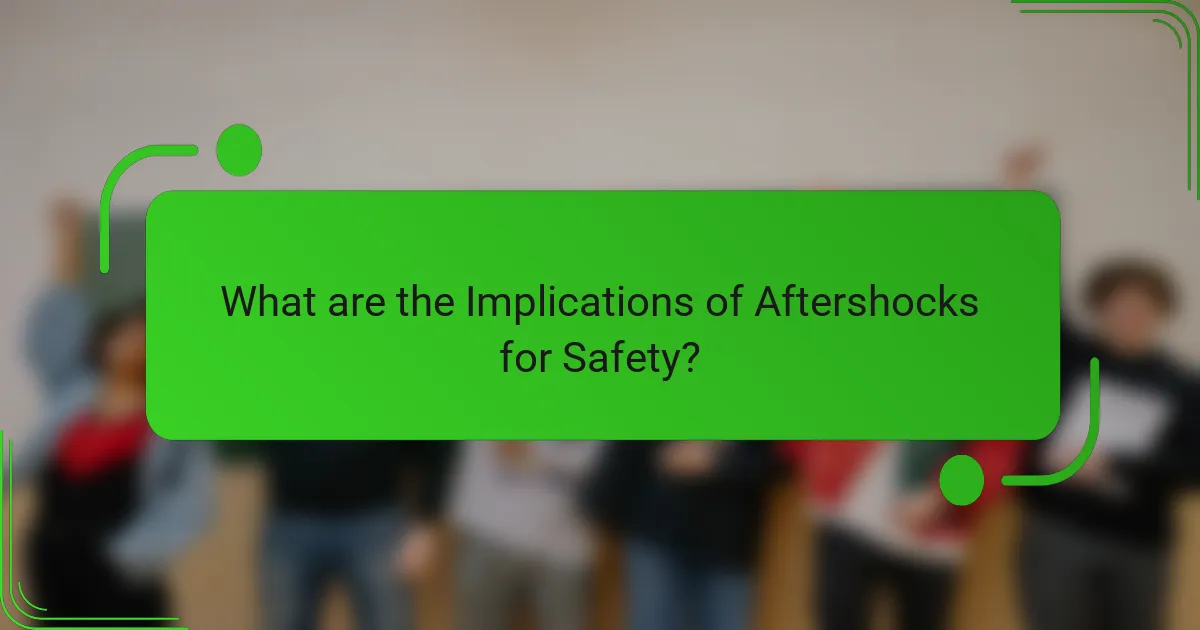
What are the Implications of Aftershocks for Safety?
Aftershocks can significantly impact safety following a major earthquake. They often occur in the days, weeks, or even months after the initial quake. Aftershocks can cause additional structural damage to already weakened buildings. This increases the risk of injury to individuals in affected areas. Emergency response efforts may be hampered as aftershocks can disrupt rescue operations. People may experience heightened anxiety and stress, affecting their mental health. Awareness and preparedness are crucial for minimizing risks during aftershocks. Following the 2011 Japan earthquake, aftershocks caused further casualties and injuries, demonstrating the importance of safety measures.
How can individuals prepare for Aftershocks?
Individuals can prepare for aftershocks by securing heavy furniture and appliances. This reduces the risk of injury during subsequent tremors. They should create an emergency kit with essential supplies like water, food, and first aid items. Having a communication plan with family members is crucial. Individuals should also identify safe spots in their homes, such as under sturdy furniture. Practicing earthquake drills can enhance readiness. Staying informed about local seismic activity helps individuals anticipate potential aftershocks. According to the U.S. Geological Survey, aftershocks can occur days to years after the main earthquake.
What safety measures should be taken during an Aftershock?
During an aftershock, individuals should seek immediate safety by moving to a clear area away from buildings and structures. Staying indoors is advised if the building is sturdy. Covering oneself under sturdy furniture can provide protection from falling debris. Remaining calm is crucial to avoid panic. Listening to emergency services for updates is important. It is recommended to have an emergency kit ready for such situations. Following these measures can reduce the risk of injury during aftershocks.
How can communities enhance resilience against Aftershocks?
Communities can enhance resilience against aftershocks by implementing preparedness strategies. These strategies include conducting regular earthquake drills to familiarize residents with safety protocols. Establishing early warning systems can provide timely alerts about seismic activity. Communities should also invest in retrofitting buildings to withstand aftershocks effectively. Creating emergency response plans that involve local organizations ensures coordinated efforts during crises. Educating the public on the risks and safety measures related to aftershocks can empower individuals to act swiftly. Research indicates that communities with proactive resilience plans experience lower impact from aftershocks. For instance, the 2011 Tōhoku earthquake response highlighted the importance of community preparedness in minimizing damage.
What are the psychological effects of Aftershocks on individuals?
Aftershocks can lead to significant psychological effects on individuals. Common responses include anxiety and heightened stress levels. People may experience symptoms of post-traumatic stress disorder (PTSD). These symptoms can manifest as flashbacks or intrusive thoughts about the initial earthquake. Research indicates that aftershocks can exacerbate feelings of fear and helplessness. Individuals may also develop avoidance behaviors, steering clear of places associated with the earthquake. Emotional responses can include irritability and mood swings. Studies show that prolonged exposure to aftershocks can lead to chronic psychological distress.
How can communities support mental health post-earthquake?
Communities can support mental health post-earthquake by providing accessible mental health resources. This includes establishing support groups for survivors to share experiences. Mental health professionals should be made available in affected areas. Communities can organize workshops focused on coping strategies. Outreach programs can educate residents about mental health issues. Local governments should allocate funding for mental health initiatives. Evidence shows that community support reduces anxiety and depression after disasters. According to a study by the American Psychological Association, social support significantly aids recovery in disaster situations.
What resources are available for coping with Aftershock anxiety?
Resources for coping with Aftershock anxiety include therapy, support groups, and educational materials. Cognitive Behavioral Therapy (CBT) is effective in addressing anxiety symptoms. Support groups provide shared experiences, which can foster community and understanding. Educational materials help individuals understand aftershocks and their psychological impacts. The National Center for PTSD offers resources specifically for trauma-related anxiety. Additionally, mindfulness and relaxation techniques can reduce anxiety levels. Research indicates that these methods improve coping strategies for individuals experiencing anxiety after seismic events.
What best practices should be followed in the aftermath of an earthquake?
Immediately check for injuries and administer first aid if necessary. Move to a safe location away from buildings and other hazards. Avoid using phones for non-emergency calls to keep lines open for emergency services. Stay tuned to local news for updates and instructions. Inspect your home for damage, especially gas leaks or structural issues. If you smell gas, turn off the gas supply and evacuate. Be prepared for aftershocks, which can occur minutes to days after the initial quake. Keep emergency supplies readily available, including water, food, and medications.
The main entity of this article is aftershocks, which are smaller seismic events that occur following a larger earthquake as the Earth’s crust adjusts to changes in stress. The article provides an in-depth analysis of aftershocks, including their characteristics, patterns, and the factors influencing their strength and frequency. It also explores methodologies for predicting aftershocks, the implications for safety, and the psychological effects on individuals. Additionally, the article discusses best practices for preparedness and community resilience in the aftermath of seismic events.
